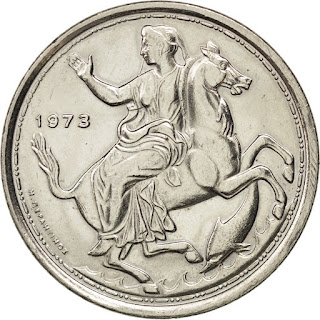Greek Coins 20 Drachmai 1973 Selene Greek Goddess of the Moon
Obverse: The Greek Moon Goddess Selene is riding sidesaddle an horse who is rearing up above a dolphin who is jumping out of the water.
Lettering: 1973.
Engraver: N. Perantinos.
Reverse: A Phoenix rising from its flames and the silhouette of the soldier bearing a rifle with fixed bayonet, the emblem of the Junta, are accompanied with the date of the coup d'état and surrounded with the facial value and the inscription "ΒΑΣΙΛΕΙΟΝ ΤΗΣ ΕΛΛΑΔΟΣ" (Kingdom of Greece).
Lettering: 21 ΑΠΡΙΛΙΟΥ 1967 • 20 ΔΡΑΧΜΑΙ • ΒΑΣΙΛΕΙΟΝ ΤΗΣ ΕΛΛΑΔΟΣ.
Engraver: V. Phalireas.
Edge: Smooth.
Metal: Copper-nickel.
Weight: 11.95 g.
Diameter: 32 mm.
Thickness: 2 mm.
Shape: Round.
Selene Greek Goddess of the Moon
In Greek mythology, Selene is the goddess of the moon. She is the daughter of the Titans Hyperion and Theia, and sister of the sun-god Helios, and Eos, goddess of the dawn. She drives her moon chariot across the heavens. Several lovers are attributed to her in various myths, including Zeus, Pan, and the mortal Endymion. In classical times, Selene was often identified with Artemis, much as her brother, Helios, was identified with Apollo. Both Selene and Artemis were also associated with Hecate, and all three were regarded as lunar goddesses, although only Selene was regarded as the personification of the moon itself. Her Roman equivalent is Luna.
She is often shown riding a horse or a bull. Selene is said to wear robes, carry a torch, and wear a half moon on her head. After her brother Helios completes his journey across the sky, she begins hers. Before Selene's journey across the night sky she bathes in the sea.

